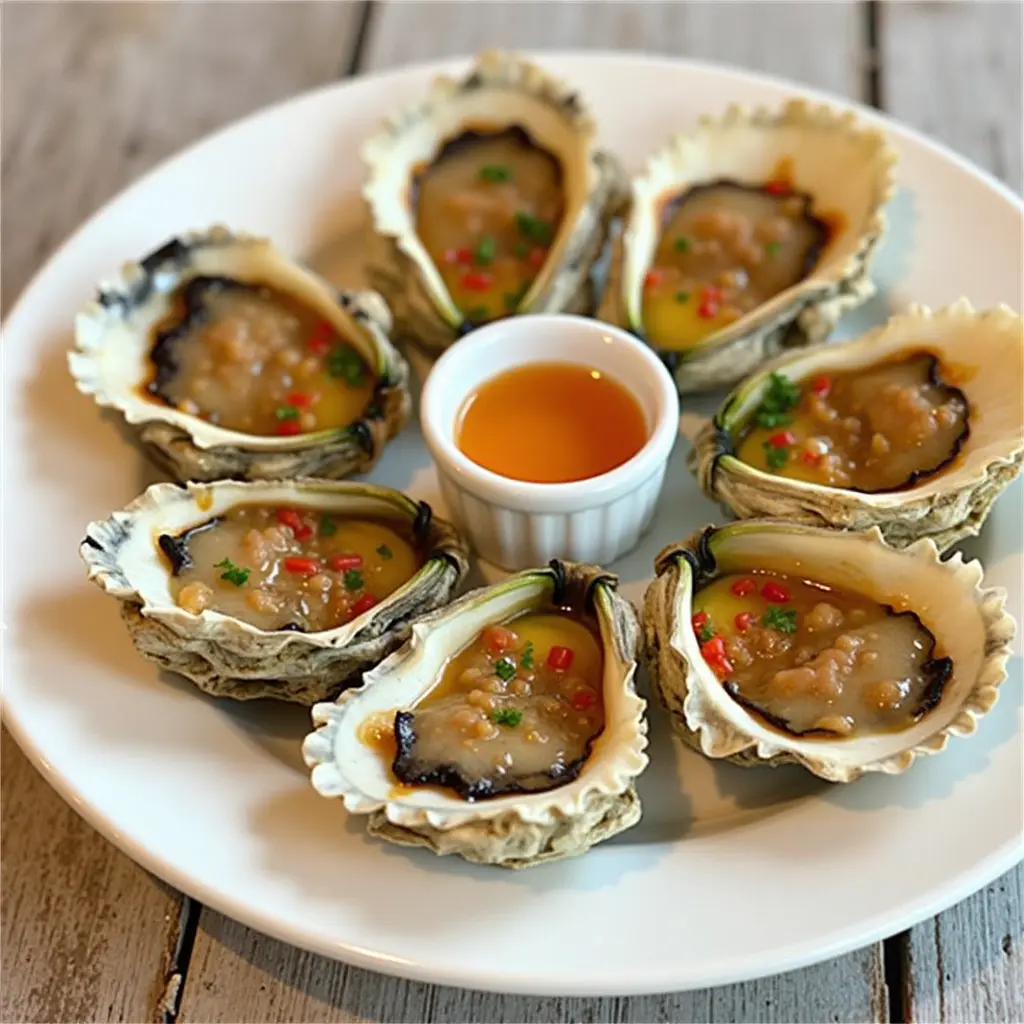
When it comes to the best Asian style oyster recipe, you’re in for a treat that combines a perfect blend of flavors from across Asia. The tender, succulent oysters paired with a mix of bold seasonings create an unforgettable dish that will make your taste buds dance. Whether you’re a seasoned seafood lover or new to enjoying oysters, this Asian-inspired dish will bring the taste of the sea straight to your table, with a delightful mix of savory, sweet, and spicy.
Ingredients for the Best Asian Style Oyster Recipe
To make the best Asian style oyster recipe, you’ll need a handful of fresh ingredients that embody the flavors of the region. Here are the main ingredients:
- Fresh Oysters – The key to a great oyster dish is to start with high-quality fresh oysters.
- Soy Sauce – A staple in Asian cooking, soy sauce provides a deep, savory flavor.
- Sesame Oil – Adds a nutty aroma and richness.
- Garlic and Ginger – The classic combination that offers warmth and aromatic depth.
- Chili Paste – Adds a bit of heat, which is optional depending on your taste.
- Green Onions – Provides freshness and a bit of crunch.
- Lemon or Lime Juice – Helps to balance the richness with acidity.
Feel free to tweak these ingredients to fit your preferences, adding more spice or sweetness as you desire.
Preparing Fresh Oysters
Before diving into the cooking process, it’s crucial to understand how to properly prepare the oysters for the best Asian style oyster recipe:
- Shucking Oysters: Carefully shuck the oysters, ensuring not to spill the oyster liquor, which holds much of the flavor.
- Cleaning: Use cold water to gently rinse off any sand or grit that might have been on the shell.
- Inspecting for Freshness: Make sure the oysters smell like the ocean—fresh and clean, without a fishy odor.
How to Cook the Best Asian Style Oyster Recipe
Pan-Seared Asian Style Oysters
One of the best ways to make the best Asian style oyster recipe is by pan-searing the oysters. This method helps to seal in all the flavors while keeping the oysters juicy.
- Heat the Pan: Use a non-stick skillet and heat it over medium heat.
- Add Sesame Oil: Add a bit of sesame oil to the pan to give the oysters a fragrant flavor.
- Sear the Oysters: Place the oysters in the hot skillet, cooking for 1-2 minutes on each side.
- Season: Pour soy sauce and sprinkle ginger, garlic, and a little bit of chili paste for heat.
- Garnish: Finish by garnishing with freshly chopped green onions and a splash of lemon juice.
Grilled Oysters with Asian Twist
Grilling is another great option for the best Asian style oyster recipe. The smoky flavor from the grill adds a new dimension to the oysters.
- Prepare the Grill: Preheat the grill to medium-high heat.
- Top with Sauce: Place each shucked oyster on the grill, adding a mixture of soy sauce, garlic, and sesame oil.
- Grill Until Bubbly: Cook until the sauce starts to bubble and the oysters become slightly firm.
- Finish with Garnish: Add finely chopped green onions and a squeeze of lemon for brightness.
What to Serve with Asian Style Oysters
When serving the best Asian style oyster recipe, you’ll want to complement the bold flavors with sides that can balance the meal. Here are some great pairing ideas:
- Steamed Jasmine Rice: Simple and soft, steamed jasmine rice allows the flavors of the oysters to shine.
- Asian Cucumber Salad: A light cucumber salad with rice vinegar and sesame seeds is a refreshing contrast.
- Garlic Noodles: Rich and buttery, garlic noodles are perfect for absorbing any leftover sauce from the oysters.
Tips for the Best Asian Style Oyster Recipe
- Use Fresh Oysters: Freshness is key to making the best Asian style oyster recipe. Fresh oysters have a clean and delicate flavor.
- Don’t Overcook: Oysters cook very quickly, so avoid overcooking as they can become tough. A couple of minutes per side is usually enough.
- Season Thoughtfully: Since soy sauce is salty, be cautious about adding extra salt.
Health Benefits of Oysters
The best Asian style oyster recipe not only offers amazing flavors but also comes with several health benefits:
- High in Protein: Oysters are an excellent source of protein, making them a great option for those looking to add more protein to their diet.
- Rich in Zinc: Oysters are famously high in zinc, which is vital for immune function and metabolic processes.
- Low in Calories: When cooked with light, fresh ingredients, oysters remain a healthy, low-calorie seafood option.
FAQs About the Best Asian Style Oyster Recipe
Can I Use Frozen Oysters for the Best Asian Style Oyster Recipe?
Yes, you can use frozen oysters, but the flavor and texture won’t be quite as good as fresh oysters. If you opt for frozen, make sure they are thawed properly before cooking. Fresh oysters are always recommended for the best Asian style oyster recipe because they retain a firmer texture and a fresher flavor.
How Do I Know If My Oysters Are Fresh?
Fresh oysters should smell like the sea—clean and briny. If they have a strong, fishy odor, they are likely past their prime. The shell should be closed tightly, or it should close when tapped.
What Can I Substitute for Soy Sauce?
If you have a soy allergy or want to reduce sodium, you can substitute soy sauce with tamari (for a gluten-free option) or coconut aminos. These substitutes provide similar umami flavors but with a unique twist.
Can I Make This Recipe Without Heat?
Absolutely! If you don’t enjoy spicy foods, simply omit the chili paste. The best Asian style oyster recipe is highly customizable, and you can adjust the heat level according to your preference.
Can I Serve These Oysters Cold?
While the best Asian style oyster recipe is usually served hot, you can also prepare a cold version by steaming the oysters lightly, then chilling them and serving with an Asian dipping sauce made from soy sauce, sesame oil, and fresh herbs.
Variations of the Best Asian Style Oyster Recipe
Oysters with Miso Butter
For a slightly different approach, try oysters with miso butter. The salty, umami-rich miso paste combined with butter creates a decadent topping that melts beautifully over the oysters.
- Make Miso Butter: Mix softened butter with a spoonful of miso paste.
- Top the Oysters: Spread a bit of this mixture over each oyster before grilling or baking.
- Finish with Lemon: Garnish with lemon juice to balance the richness of the butter.
Spicy Korean Gochujang Oysters
If you love a spicy kick, gochujang (a Korean chili paste) adds a wonderful heat and depth to the best Asian style oyster recipe.
- Prepare the Sauce: Mix gochujang, sesame oil, soy sauce, and a bit of honey.
- Top and Cook: Add this spicy mixture to your oysters before grilling for a unique flavor experience.
Common Mistakes to Avoid
- Overcooking the Oysters: Oysters can quickly turn rubbery if overcooked, so watch them closely.
- Using Too Much Sauce: Remember, oysters have a delicate flavor that can be overwhelmed by too much sauce. The key to the best Asian style oyster recipe is balance.
- Not Preheating the Grill or Pan: Make sure your cooking surface is hot before adding the oysters. This helps to sear them quickly without overcooking.
Storing and Reheating Oysters
- Storing: Fresh oysters should be kept on ice and consumed within a day or two of purchase.
- Reheating: Oysters are best enjoyed fresh, but if you need to reheat them, do so gently in a skillet with a bit of oil to prevent them from drying out.
Best Drinks to Pair with Asian Style Oysters
To truly elevate the best Asian style oyster recipe, consider pairing it with one of these drinks:
- Sake: The clean, crisp flavors of sake complement the salty, umami-rich flavors of oysters.
- White Wine: A chilled glass of dry white wine, like Sauvignon Blanc, pairs wonderfully with oysters.
- Green Tea: If you prefer a non-alcoholic option, a cup of green tea can provide a nice, earthy contrast to the briny oysters.
Why This Recipe Stands Out
The best Asian style oyster recipe is beloved for its perfect balance of flavors—savory, spicy, and slightly sweet. The combination of soy sauce, sesame oil, and fresh aromatics like garlic and ginger gives the oysters an incredible depth of flavor while still allowing their natural taste to shine through. It’s a dish that feels both comforting and exotic, making it a favorite among seafood enthusiasts.

